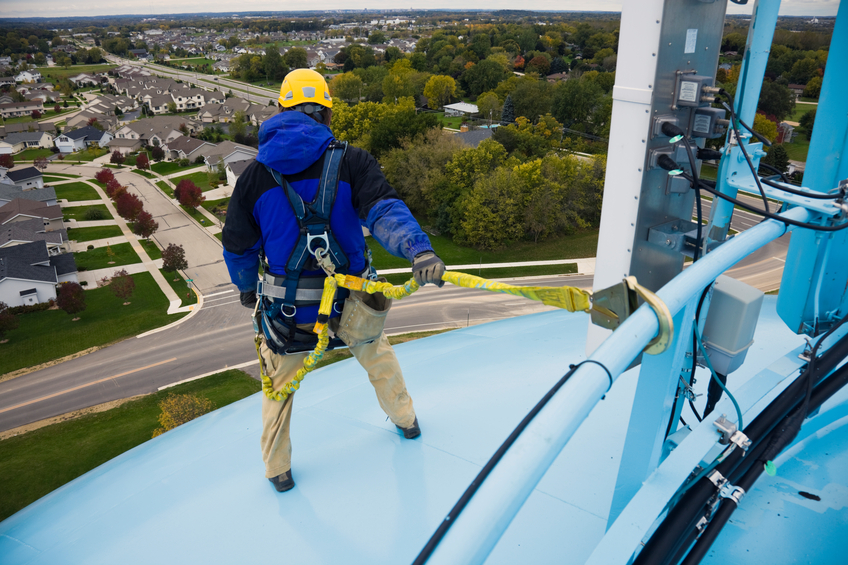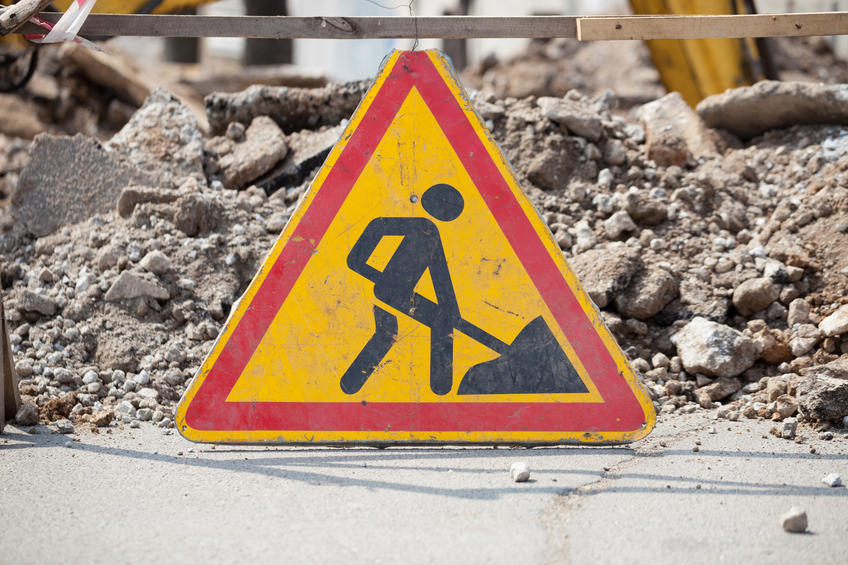Alaska Construction Safety 24 PDH Discount Package 2
Courses in this Package
Scaffold Use in the Construction Industry (S06-001)
Fall Protection in Construction (C03-057)
Ground-Fault Protection on Construction Sites (E01-001)
Safety Evaluation of Centerline and Shoulder Rumble Strips (C04-048)
Operational Safety on Airports During Construction (C07-016)
Photovoltaic Systems Safety (E03-028)

This online engineering PDH course provides OSHA guidance on scaffolds for protecting workers using scaffolding systems on construction sites.
Scaffolding hazards continue to rank high on the list of most frequently cited standards in the construction industry. Workers involved in working on scaffolding systems are exposed to potential fall hazards. Scaffold-related accidents account for a significant number of fatalities in the construction workplace.
OSHA recognizes that working on scaffolding systems present serious hazards to all workers involved. Therefore, OSHA developed the Scaffold Standard to protect workers using scaffolding systems on construction sites.
This 6 PDH online course is applicable to employers/business owners, engineers, managers, construction contractors/workers and any other personnel working on construction projects that require scaffolding.
This PE continuing education course is intended to provide you with the following specific knowledge and skills:
- Scaffold capacity requirements
- Scaffold platform requirements
- Criteria for supported scaffolds versus suspended scaffolds
- Access and use requirements
- Fall and falling object requirements
- Specific scaffold and aerial lift requirements
- Training requirements
- Construction focused inspection guidelines
In this professional engineering CEU course, you need to review OSHA 3150, "A Guide to Scaffold Use in the Construction Industry".
Upon successful completion of the quiz, print your Certificate of Completion instantly. (Note: if you are paying by check or money order, you will be able to print it after we receive your payment.) For your convenience, we will also email it to you. Please note that you can log in to your account at any time to access and print your Certificate of Completion.

This online engineering PDH course presents the OSHA guidelines for fall protection for protecting workers against potential fall hazards.
Historically, falls are the leading cause of fatalities in construction, accounting for about one-third of all fatalities in the industry. Workers involved in working at heights are exposed to potential fall hazards. Accidents involving falls are generally complex events frequently involving a variety of factors
OSHA recognizes that working at heights presents serious hazards to all workers involved. Consequently, the standard for fall protection deals with both the human and equipment-related issues in protecting workers from fall hazards.
This 3 PDH online course is intended for employers/business owners, engineers, managers and construction workers interested in better understanding the Fall Protection in Construction requirements and the reasons behind them.
This PE continuing education course is intended to provide you with the following specific knowledge and skills:
- Identifying potential fall hazards
- Selecting fall protection systems appropriate for existing conditions
- Implementing proper construction and installation of safety systems
- Training and supervising employees in the proper selection, use and maintenance of fall protection systems
In this professional engineering CEU course, you need to review the OSHA Standard, "Fall Protection in Construction", (OSHA 3146), published in 2015.
Once you complete your course review, you need to take a multiple-choice quiz consisting of twenty (20) questions to earn 3 PDH credits. The quiz will be based on this OSHA publication.
Upon successful completion of the quiz, print your Certificate of Completion instantly. (Note: if you are paying by check or money order, you will be able to print it after we receive your payment.) For your convenience, we will also email it to you. Please note that you can log in to your account at any time to access and print your Certificate of Completion.

This online engineering PDH course provides OSHA's electrical requirements for ground fault circuit interrupters to protect workers against electrical hazards.
With the wide use of portable tools on construction sites, the use of flexible cords often becomes necessary. Hazards are created when cords, cord connectors, receptacles, and cord- and plug-connected equipment are improperly used and maintained. Shocks, burns or fire-related fatalities resulting from humans exposed to non-grounded equipment significantly contribute to the overall number of fatalities in the construction workplace.
OSHA recognizes that non-grounded equipment present serious hazards to all workers involved. Therefore, OSHA developed the Electrical Standard that contains the requirements for ground fault circuit interrupters (GFCIs) to protect workers against 120-volt electrical hazards on the construction site.
This 1 PDH online course is applicable to employers/business owners, engineers, managers, electricians, construction workers and any other personnel working with or around energized equipment that require grounding.
This PE continuing education course is intended to provide you with the following specific knowledge and skills:
- What is a GFCI
- What are some other ways to prevent electrical injury
- How can employers protect their workers
- What is the assured equipment grounding conductor program
In this professional engineering CEU course, you need to review OSHA 3007, "Ground-Fault Protection on Construction Sites".
Upon successful completion of the quiz, print your Certificate of Completion instantly. (Note: if you are paying by check or money order, you will be able to print it after we receive your payment.) For your convenience, we will also email it to you. Please note that you can log in to your account at any time to access and print your Certificate of Completion.

This online engineering PDH course describes the strategy involving the application of shoulder rumble strips (SRS) and centerline rumble strips (CLRS) in combination. This strategy is intended to reduce the frequency of crashes by alerting drivers that they are about to leave the travelled lane. While research has been published on the safety effectiveness of SRS or CLRS used in isolation, the effectiveness of the combined treatment has not been shown.
Geometric, traffic, and crash data were obtained at treated two-lane rural road locations in Kentucky, Missouri and Pennsylvania. To account for potential selection bias and regression-to-the-mean, an Empirical Bayes (EB) before-after analysis was conducted using reference groups of untreated two-lane rural roads with similar characteristics to the treated sites. A slightly different approach was required for the analysis of the treatment sites in Missouri, which is installing rumble strips on two-lane rural roads whenever a resurfacing project is undertaken. As a result, a suitable reference group with no rumble strips for this road type presently or in the near future did not exist. The analysis also controls for changes in traffic volumes over time and time trends in crash counts unrelated to the treatment.
This 4 PDH online course is intended for traffic engineers, design professionals and construction personnel who are involved in the design and application of centerline and shoulder rumble strips.
This PE continuing education course is intended to provide you with the following specific knowledge and skills:
- Understanding the background information about the strategy and the study
- Familiarizing with previous research of SRS and CLRS
- Learning about the Empirical Bayes (EB) methodology used for the evaluation
- Understanding the data collection of the three States in study
- Familiarizing with the SPFs developed for each State
- Familiarizing with the before-after evaluation results of crashes
Upon successful completion of the quiz, print your Certificate of Completion instantly. (Note: if you are paying by check or money order, you will be able to print it after we receive your payment.) For your convenience, we will also email it to you. Please note that you can log in to your account at any time to access and print your Certificate of Completion.

This online engineering PDH course discusses the key areas for maintaining safety during construction at an airport. It presents details on how to maintain a functioning airport during construction, how to keep construction zones safe, and when to have specific zones open or close during construction.
Safety at construction zones is paramount, and this is even more so at airports where multiple stakeholders are involved in the construction process, including but not limited to the FAA, airport operators, contractors, airport users, and military personnel (at military airports).
This 7 PDH online course is applicable to architects, construction managers, safety, civil, electrical, mechanical, and industrial engineers as well as others interested in learning more about how construction at an airport can be performed safely.
This PE continuing education course is intended to provide you with the following specific knowledge and skills:
- Understanding why maintaining safety at an airport during construction is important
- Learning how to best keep all involved parties and stakeholders safe
- Understanding what is involved in creating a construction safety and phasing plan (CSPP)
- Familiarizing with the guidelines on how to create a construction safety and phasing plan (CSPP)
Upon successful completion of the quiz, print your Certificate of Completion instantly. (Note: if you are paying by check or money order, you will be able to print it after we receive your payment.) For your convenience, we will also email it to you. Please note that you can log in to your account at any time to access and print your Certificate of Completion.

This online engineering PDH course provides helpful and easily-accessible instructions on how to work safely with photovoltaic (PV) systems. Some recommendations are based on the common sense and they will help readers to keep safe. This course includes description of specific hazards, their frequent causes, and ways to prevent and avoid them.
This course has three different sections:
- PV System Characteristics and Hazards section provides the background of PV system characteristics and relevant hazards involved with PV systems. Recommended safe-guards are provided.
- Safe PV Systems section presents a discussion of relevant safety standards and codes, and regulations that need to be followed and applied when designing, installing, testing and commissioning a PV system.
- The For Your Health section contains a discussion of possible injuries and elaborates on basic First Aid concepts.
Each section presents specific hazards to engineers, technicians and maintenance staff. Helping you distinguish these hazards and avert injury is the main goal of this course.
This 3 PDH online course is suitable for engineers involved in PV system installation and operation. The details presented cover issues related to safe work practices with PV systems. Upon successful completion, you will be able to recognize critical PV safety issues and will learn ways to avoid potential accidents.
This PE continuing education course is intended to provide you with the following specific knowledge and skills:
- PV system characteristics and potential hazards
- Relevant safety standards and codes
- Possible injuries and basic first aid concepts
In this professional engineering CEU course, you need to review the course document titled “PV Systems Safety”.
Once you complete your course review, you need to take a multiple-choice quiz consisting of twenty five (25) questions to earn 3 PDH credits.
Upon successful completion of the quiz, print your Certificate of Completion instantly. (Note: if you are paying by check or money order, you will be able to print it after we receive your payment.) For your convenience, we will also email it to you. Please note that you can log in to your account at any time to access and print your Certificate of Completion.